St. Mary's Church and Canovium, Conwy
20/08/18 20:25 Filed in: DailyDeliveryPhoto
In north Wales again today and was delivering around the Conwy valley between Conwy and Dolgarrog and Glad Conwy. Saw a sign for an 'Historic Church' when around the same route a week or two ago and today decided to go and have a gander - sounds familiar? Again it was very worth while. The church turned out to be the Parish Church for the Rowen district: St.Mary's Church.
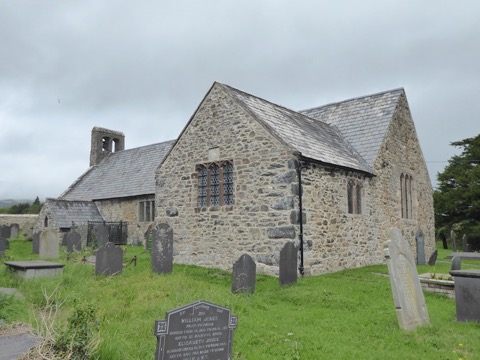
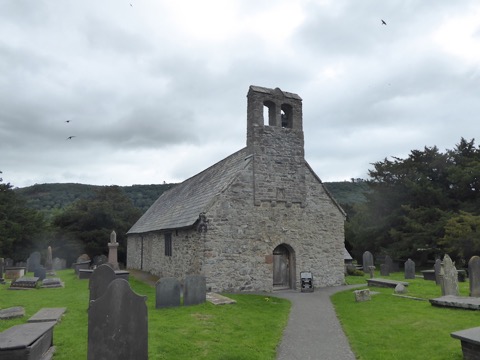
St.Mary's Church (with a few swallows in the air there)
It's in an isolated spot on the banks of the Conwy and is a thirteenth century church thought to have been built by Cistercian monks from Maenan Abbey. And whilst there are no other buildings currently within about half a kilometre of the church there used to be a lot going on here as the church was constructed on the north eastern corner of a Roman Fort constructed around 75AD. The settlement was known as Canovium a timber built fort which housed around 500 foot soldiers which were there to look after the river crossing at Tal-y-cafn. The site is thought to have been in use at least for the bulk of time from then until the fourth century.
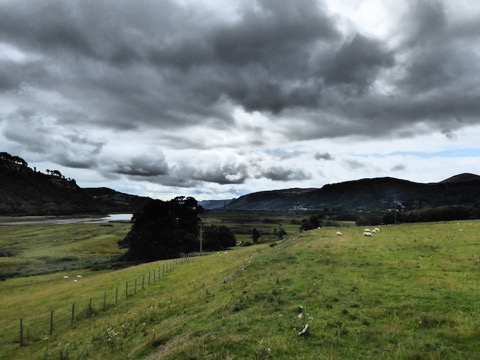
View south along the top of the embankment used by the Roman Fort
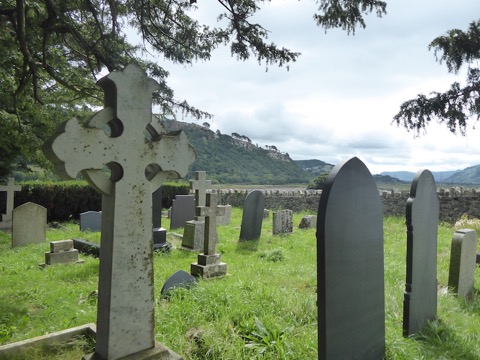
The markings in the arable and sheep grazed fields have been very strong this year with the dry summer and there have been some great aerial photographs showing the layout of some of the Roman buildings such as the bath house. The most obvious evidence of the fort though is the rectangular platform of the fort which the church sits on the north east corner of.

The sky was alive with swallows and I saw hawfinches in and around the churchyard - but unfortunately I could not get any photos of them. They are elusive indeed.
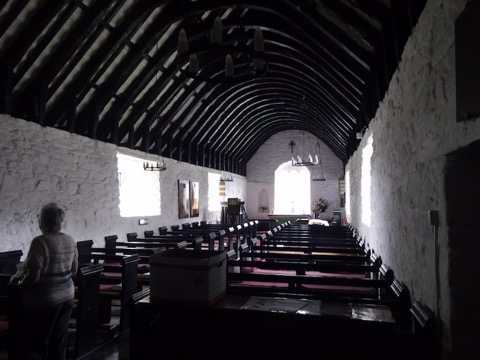
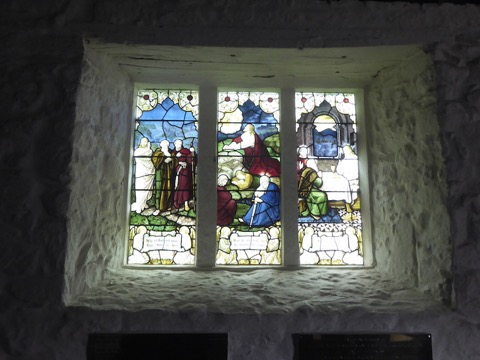
The church itself is a familiar shape and appearance in this area of Wales. It has a double bell cote though apparently there is no evidence that there has ever been more than the one bell which is currently there. There is an interesting medieval stone crucifix above the entrance to the church. The tidy church unlike the one at Celynnin is still in use - as I say it is the Parish Church. There is a lovely stained glass window on the the left as you come in. But with only small windows it was pretty dark in there.

Medieval cross
The churchyard is pretty and the setting with the River Conwy below the embankments of the old fort and the hills forming the valley make the spot very attractive. There are two ancient Yews in the churchyard. Unfortunately one has crashed some of its substantial branches on to some of the grave stones which were marked off with tape. The gravestones are well worth a wander around and it's amazing to see the longevity of some of the locals from the 1800s - forget the Mediterranean Diet, what were they eating in the Conwy Valley back then? And whilst you're looking at the inscriptions it's worth keeping an eye out for those hawfinches.


St.Mary's Church (with a few swallows in the air there)
It's in an isolated spot on the banks of the Conwy and is a thirteenth century church thought to have been built by Cistercian monks from Maenan Abbey. And whilst there are no other buildings currently within about half a kilometre of the church there used to be a lot going on here as the church was constructed on the north eastern corner of a Roman Fort constructed around 75AD. The settlement was known as Canovium a timber built fort which housed around 500 foot soldiers which were there to look after the river crossing at Tal-y-cafn. The site is thought to have been in use at least for the bulk of time from then until the fourth century.

View south along the top of the embankment used by the Roman Fort

The markings in the arable and sheep grazed fields have been very strong this year with the dry summer and there have been some great aerial photographs showing the layout of some of the Roman buildings such as the bath house. The most obvious evidence of the fort though is the rectangular platform of the fort which the church sits on the north east corner of.

The sky was alive with swallows and I saw hawfinches in and around the churchyard - but unfortunately I could not get any photos of them. They are elusive indeed.


The church itself is a familiar shape and appearance in this area of Wales. It has a double bell cote though apparently there is no evidence that there has ever been more than the one bell which is currently there. There is an interesting medieval stone crucifix above the entrance to the church. The tidy church unlike the one at Celynnin is still in use - as I say it is the Parish Church. There is a lovely stained glass window on the the left as you come in. But with only small windows it was pretty dark in there.

Medieval cross
The churchyard is pretty and the setting with the River Conwy below the embankments of the old fort and the hills forming the valley make the spot very attractive. There are two ancient Yews in the churchyard. Unfortunately one has crashed some of its substantial branches on to some of the grave stones which were marked off with tape. The gravestones are well worth a wander around and it's amazing to see the longevity of some of the locals from the 1800s - forget the Mediterranean Diet, what were they eating in the Conwy Valley back then? And whilst you're looking at the inscriptions it's worth keeping an eye out for those hawfinches.
blog comments powered by Disqus